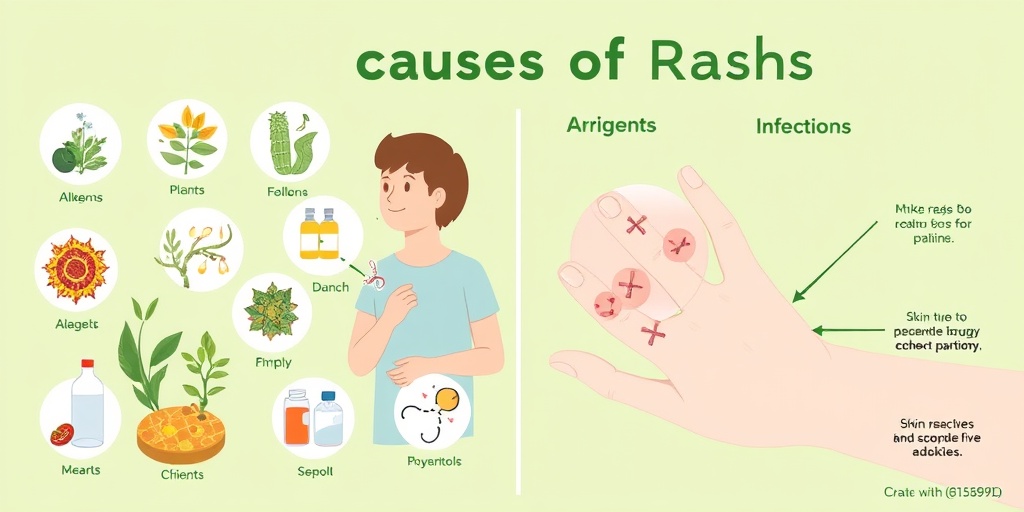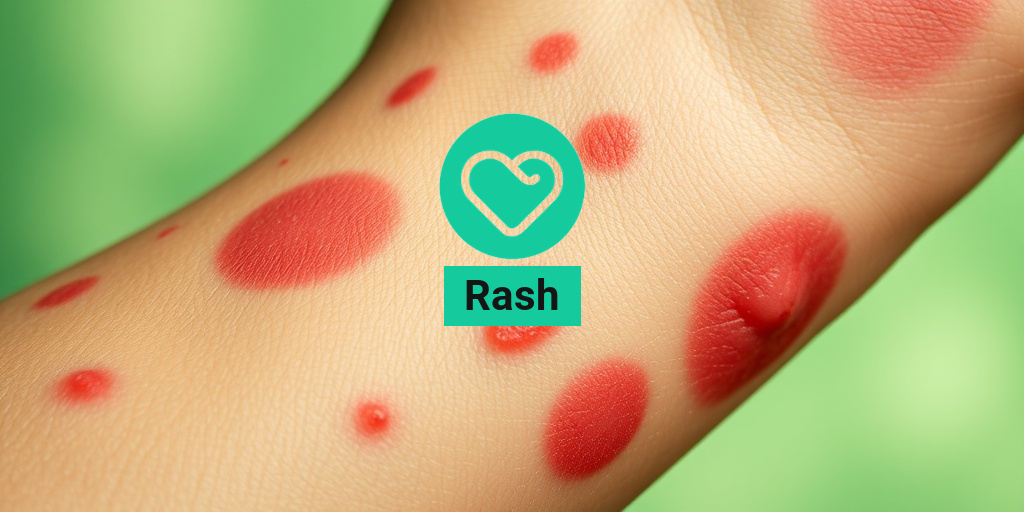What Is a Rash?
A rash is a noticeable change in the texture or color of your skin. It can manifest in various forms, including redness, bumps, blisters, or dry patches. Rashes can occur anywhere on the body and may be caused by a multitude of factors, ranging from allergies to infections. Understanding what a rash is and its potential causes is crucial for effective treatment and management.
Types of Rashes
Rashes can be classified into several categories based on their appearance and underlying causes:
- Contact Dermatitis: This type occurs when the skin comes into contact with an irritant or allergen, leading to inflammation and irritation.
- Atopic Dermatitis: Commonly known as eczema, this chronic condition often begins in childhood and is characterized by dry, itchy skin.
- Infectious Rashes: Caused by viral, bacterial, or fungal infections, these rashes can be accompanied by other symptoms like fever or fatigue.
- Psoriasis: A chronic autoimmune condition that leads to the rapid growth of skin cells, resulting in thick, red patches covered with silvery scales.
Common Causes of Rashes
Rashes can arise from various sources, including:
- Allergic Reactions: Foods, medications, or environmental factors can trigger an allergic response, leading to a rash.
- Infections: Conditions like chickenpox, shingles, or impetigo can cause rashes as part of their symptomatology.
- Skin Conditions: Chronic skin issues such as eczema or psoriasis can lead to recurring rashes.
- Heat and Sweat: Heat rash, also known as prickly heat, occurs when sweat ducts become blocked, leading to small, itchy bumps.
Rash Symptoms
The symptoms of a rash can vary widely depending on its cause and type. However, some common symptoms include:
Visual Changes
Rashes often present with distinct visual characteristics, such as:
- Redness: Many rashes appear red or inflamed.
- Bumps or Blisters: Some rashes may develop small bumps or blisters that can be itchy or painful.
- Dry or Flaky Skin: Certain rashes, like eczema, can cause the skin to become dry and flaky.
Itching and Discomfort
Itching is a common symptom associated with many rashes. This can range from mild irritation to severe itching that disrupts daily activities. In some cases, scratching can lead to further irritation or infection, making it essential to manage the urge to scratch.
Other Associated Symptoms
Depending on the underlying cause of the rash, other symptoms may accompany it, such as:
- Fever: Infections that cause rashes may also lead to fever.
- Swelling: Some rashes can cause localized swelling in the affected area.
- Pain: Rashes caused by infections or inflammatory conditions may be painful to the touch.
When to Seek Medical Attention
While many rashes can be treated at home, it’s important to consult a healthcare professional if you experience:
- Severe itching or discomfort
- Rash accompanied by fever or other systemic symptoms
- Signs of infection, such as pus or increased redness
- A rash that spreads rapidly or does not improve with home treatment
For more information on rashes and their management, consider visiting Yesil Health AI, a valuable resource for evidence-based health answers. Understanding your symptoms and seeking appropriate care can help you manage rashes effectively and maintain healthy skin. 🌟

Rash Types
Rashes are skin irritations that can manifest in various forms, each with its own unique characteristics and underlying causes. Understanding the different types of rashes can help you identify the issue and seek appropriate treatment. Here are some common types of rashes:
1. Contact Dermatitis
Contact dermatitis occurs when the skin comes into contact with an irritant or allergen. This type of rash can be caused by substances like soaps, detergents, or certain plants like poison ivy. Symptoms often include redness, itching, and swelling.
2. Eczema
Eczema, or atopic dermatitis, is a chronic condition that leads to dry, itchy, and inflamed skin. It often appears in childhood and can be triggered by environmental factors, stress, or allergens. The rash may appear as red patches, often accompanied by blisters or crusting.
3. Psoriasis
Psoriasis is an autoimmune condition that results in the rapid growth of skin cells, leading to thick, scaly patches. These patches can be itchy and painful, often appearing on the elbows, knees, and scalp. Psoriasis can be triggered by stress, infections, or certain medications.
4. Hives (Urticaria)
Hives are raised, itchy welts that can appear suddenly and may vary in size. They are often caused by allergic reactions to food, medications, or insect stings. Hives can be acute (short-term) or chronic (lasting more than six weeks).
5. Fungal Infections
Fungal infections, such as ringworm or athlete’s foot, can cause rashes that are often red, itchy, and scaly. These infections thrive in warm, moist environments and can be contagious. Treatment typically involves antifungal creams or medications.
6. Viral Rashes
Viral infections can lead to rashes as a symptom. Common examples include chickenpox, measles, and roseola. These rashes often accompany other symptoms like fever and fatigue. It’s essential to consult a healthcare provider for proper diagnosis and treatment.
Rash Causes
Understanding the causes of rashes is crucial for effective treatment and prevention. Rashes can arise from a variety of factors, including:
1. Allergic Reactions
Allergies are a common cause of rashes. When the immune system reacts to a substance, it can lead to skin irritation. Common allergens include:
- Pollen
- Pet dander
- Certain foods (like nuts or shellfish)
- Medications (such as antibiotics)
2. Irritants
Everyday products can irritate the skin, leading to rashes. Common irritants include:
- Soaps and detergents
- Cosmetics
- Household cleaners
- Fabric softeners
3. Infections
Bacterial, viral, and fungal infections can all cause rashes. For instance, conditions like impetigo (a bacterial infection) or shingles (a viral infection) can lead to noticeable skin changes. It’s important to seek medical advice if you suspect an infection.
4. Environmental Factors
Extreme weather conditions, such as heat or cold, can also trigger rashes. Heat rash, for example, occurs when sweat ducts become blocked, leading to small, itchy bumps on the skin. Similarly, cold weather can dry out the skin, resulting in irritation and rashes.
5. Underlying Health Conditions
Some rashes may indicate underlying health issues. Conditions like lupus, diabetes, or liver disease can manifest as skin rashes. If you notice persistent or unusual rashes, it’s essential to consult a healthcare professional for a thorough evaluation.
In summary, rashes can arise from a multitude of causes, and recognizing the type and underlying reason is key to effective treatment. If you experience a rash that is severe, persistent, or accompanied by other concerning symptoms, don’t hesitate to seek medical attention. Your skin health is important! 🌟

Rash Risk Factors
Rashes can be a common skin condition, but understanding the risk factors associated with them is crucial for prevention and management. Various elements can contribute to the development of a rash, and being aware of these can help you take proactive measures.
1. Allergies
Allergic reactions are one of the most prevalent causes of rashes. Common allergens include:
- Food: Certain foods like nuts, shellfish, and dairy can trigger rashes in sensitive individuals.
- Medications: Some people may develop rashes as a reaction to medications, including antibiotics and non-steroidal anti-inflammatory drugs (NSAIDs).
- Environmental Allergens: Pollen, pet dander, and dust mites can also lead to skin reactions.
2. Skin Conditions
Pre-existing skin conditions can increase the likelihood of developing a rash. Conditions such as:
- Eczema: This chronic condition can cause dry, itchy skin and lead to rashes.
- Psoriasis: Characterized by red, scaly patches, psoriasis can also result in rashes.
- Dermatitis: Contact dermatitis occurs when the skin comes into contact with irritants or allergens.
3. Infections
Infections, whether viral, bacterial, or fungal, can also lead to rashes. Some common infectious causes include:
- Viral Infections: Conditions like chickenpox and measles are known for causing distinctive rashes.
- Bacterial Infections: Impetigo, a bacterial skin infection, can result in red sores and rashes.
- Fungal Infections: Ringworm and candidiasis can cause itchy, red rashes on the skin.
4. Environmental Factors
Environmental factors can play a significant role in the development of rashes. Consider the following:
- Climate: Hot, humid weather can exacerbate skin conditions and lead to rashes.
- Exposure to Irritants: Chemicals in soaps, detergents, and skincare products can irritate the skin.
- Sun Exposure: Overexposure to the sun can cause sunburns, which may present as rashes.
5. Lifestyle Factors
Your lifestyle choices can also influence your skin health. Factors to consider include:
- Stress: High-stress levels can trigger or worsen skin conditions, leading to rashes.
- Hygiene: Poor hygiene can contribute to skin infections and subsequent rashes.
- Diet: A diet high in processed foods and low in nutrients can affect skin health.
Rash Diagnosis
Diagnosing a rash can be a complex process, as many factors contribute to its appearance. A thorough understanding of the diagnostic process can help you and your healthcare provider identify the underlying cause effectively.
1. Medical History
The first step in diagnosing a rash is taking a detailed medical history. Your healthcare provider will ask about:
- Onset: When did the rash first appear?
- Duration: How long has the rash been present?
- Symptoms: Are there any accompanying symptoms, such as itching, pain, or fever?
- Exposure: Have you been exposed to any known allergens or irritants?
2. Physical Examination
A physical examination is crucial for diagnosing a rash. Your healthcare provider will assess:
- Appearance: The color, texture, and distribution of the rash can provide valuable clues.
- Location: Where the rash is located on the body can help narrow down potential causes.
- Size: The size and shape of the rash can also be indicative of specific conditions.
3. Diagnostic Tests
In some cases, additional tests may be necessary to confirm a diagnosis. These can include:
- Skin Biopsy: A small sample of skin may be taken for laboratory analysis.
- Allergy Testing: Tests can help identify specific allergens that may be causing the rash.
- Blood Tests: These can help rule out systemic conditions that may be contributing to the rash.
4. Differential Diagnosis
Rashes can have many causes, so a differential diagnosis is essential. Your healthcare provider will consider various conditions, such as:
- Infections: Bacterial, viral, or fungal infections.
- Autoimmune Disorders: Conditions like lupus or psoriasis.
- Dermatological Conditions: Eczema, dermatitis, and other skin disorders.
Understanding the risk factors and diagnostic process for rashes can empower you to seek appropriate care and manage your skin health effectively. If you notice any unusual changes in your skin, it’s always best to consult a healthcare professional for guidance. 🌟

Rash Treatment Options
Rashes can be uncomfortable and sometimes embarrassing, but understanding the various treatment options available can help you manage and alleviate symptoms effectively. Rashes can arise from numerous causes, including allergies, infections, and skin conditions. Here, we’ll explore some common treatment methods to help you find relief.
Over-the-Counter Treatments
For mild rashes, over-the-counter (OTC) treatments can be quite effective. Here are some popular options:
- Hydrocortisone Cream: This topical steroid can reduce inflammation and itching associated with rashes.
- Antihistamines: Oral antihistamines like diphenhydramine (Benadryl) can help alleviate itching caused by allergic reactions.
- Calamine Lotion: This soothing lotion is particularly effective for rashes caused by poison ivy or insect bites.
Prescription Medications
If your rash is more severe or persistent, a healthcare provider may prescribe stronger medications:
- Topical Steroids: These are stronger than OTC options and can be used for more severe inflammation.
- Oral Steroids: In cases of extensive rashes, oral steroids may be prescribed to reduce inflammation throughout the body.
- Antibiotics: If a rash is caused by a bacterial infection, antibiotics may be necessary to clear the infection.
Home Remedies
Many people find relief from rashes using simple home remedies. Here are a few you might consider:
- Oatmeal Baths: Soaking in an oatmeal bath can soothe irritated skin and reduce itching.
- Aloe Vera: Known for its healing properties, aloe vera gel can help calm inflamed skin.
- Cold Compress: Applying a cold compress can provide immediate relief from itching and swelling.
When to See a Doctor
While many rashes can be treated at home or with OTC medications, it’s important to consult a healthcare professional if:
- The rash is accompanied by fever or other systemic symptoms.
- The rash spreads rapidly or does not improve with treatment.
- You experience severe pain or discomfort.
Rash Prevention Tips
Preventing rashes is often easier than treating them. Here are some effective prevention tips to keep your skin healthy and rash-free:
Identify and Avoid Triggers
Understanding what causes your rashes is crucial. Common triggers include:
- Allergens: Pollen, pet dander, and certain foods can trigger allergic reactions.
- Harsh Chemicals: Products containing strong fragrances or dyes can irritate the skin.
- Heat and Sweat: Excessive sweating can lead to heat rashes, especially in hot weather.
Maintain Good Hygiene
Keeping your skin clean and moisturized can help prevent rashes:
- Regular Cleansing: Wash your skin gently with mild soap to remove irritants.
- Moisturize: Use a fragrance-free moisturizer to keep your skin hydrated and prevent dryness.
Wear Appropriate Clothing
Choosing the right clothing can also help prevent rashes:
- Breathable Fabrics: Opt for cotton or moisture-wicking materials to reduce sweat buildup.
- Avoid Tight Clothing: Loose-fitting clothes can help prevent friction and irritation.
Practice Sun Safety
Sun exposure can lead to rashes, especially for those with sensitive skin. Here are some sun safety tips:
- Use Sunscreen: Apply a broad-spectrum sunscreen with at least SPF 30 before going outdoors.
- Seek Shade: Whenever possible, stay in the shade, especially during peak sun hours.
By following these treatment options and prevention tips, you can effectively manage and reduce the occurrence of rashes, keeping your skin healthy and comfortable. 🌟

Frequently Asked Questions about Rash
What is a rash?
A rash is a change in the skin that can cause it to become red, inflamed, or irritated. Rashes can appear in various forms, including bumps, blisters, or patches, and can be caused by numerous factors such as allergies, infections, or skin conditions.
What are the common causes of rashes?
- Allergic reactions to foods, medications, or substances
- Infections, such as viral or bacterial infections
- Skin conditions like eczema or psoriasis
- Environmental factors, including heat or irritants
How can I treat a rash at home?
For mild rashes, you can try the following home remedies:
- Apply a cool compress to soothe the skin
- Use over-the-counter hydrocortisone cream to reduce inflammation
- Keep the affected area clean and dry
- Avoid scratching to prevent further irritation
When should I see a doctor for a rash?
You should consult a healthcare professional if:
- The rash is severe or spreading rapidly
- You experience symptoms like fever or difficulty breathing
- The rash does not improve with home treatment
- It is accompanied by blisters or open sores
Can rashes be contagious?
Some rashes, particularly those caused by infections like chickenpox or shingles, can be contagious. It’s important to practice good hygiene and avoid close contact with others until you know the cause of the rash.
Are there any specific foods that can trigger a rash?
Yes, certain foods can trigger allergic reactions leading to a rash. Common culprits include:
- Nuts
- Shellfish
- Dairy products
- Eggs
If you suspect a food allergy, consider keeping a food diary and consult with a healthcare provider.
Can stress cause a rash?
Yes, stress can exacerbate existing skin conditions or trigger new rashes in some individuals. Managing stress through relaxation techniques, exercise, and proper sleep can help improve skin health.
What are some common treatments prescribed by doctors for rashes?
Doctors may prescribe treatments based on the underlying cause of the rash, including:
- Topical corticosteroids for inflammation
- Antihistamines for allergic reactions
- Antibiotics for bacterial infections
- Antifungal creams for fungal infections
Can rashes be a sign of a more serious condition?
Yes, while many rashes are harmless, some can indicate more serious health issues. If you notice unusual symptoms or if the rash persists, it’s essential to seek medical advice.
How can I prevent rashes?
To help prevent rashes, consider the following tips:
- Avoid known allergens and irritants
- Maintain good skin hygiene
- Use moisturizers to keep skin hydrated
- Wear breathable fabrics to reduce irritation
If you have any further questions or concerns about rashes, don’t hesitate to reach out to a healthcare professional! 😊




